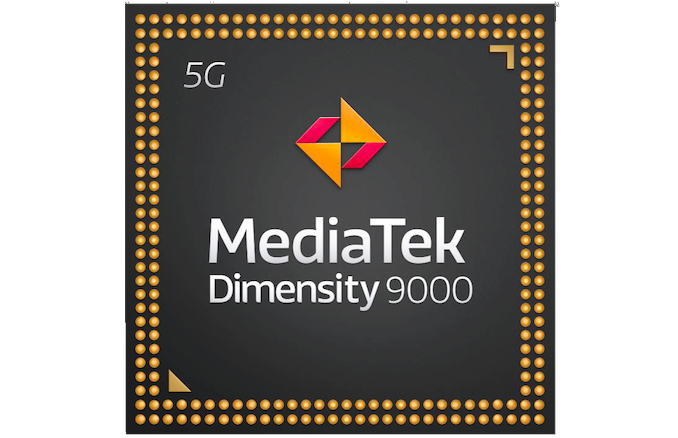
The Dimensity 9000 brings with it a lot of firsts including it being the first SoC to be fabbed on the TSMC 4 nm process and sporting the first ARM v9 CPUs including a Cortex-X2 core at 3.05 GHz, 3x Cortex-A710 cores at 2.85 GHz, and 4x Cortex-A510 cores at 1.8 GHz. These ARM v9 CPUs will be paired with LPDDR5x RAM that runs at 7,500 Mbps but 6,400 Mbps chips will be supported as well.
The Cortex-X2 running at 3.05 GHz is clocked higher than the X1 Core of the Snapdragon 888 and Exynos 2100 and features 1 MB of L2 cache. In single-core benchmarks, MediaTek claims up to a 35% system-level performance bump and up to a 10% improvement in core-level performance over the current "Android flagship", which, for all intents and purposes, can be considered to be the Snapdragon 888.
The three Cortex-A710 middle cores are also quite powerful with 512 KB L2 caches and up to a 2.85 GHz clock similar to the Cortex-A78 middle cores at 2.8 GHz found in the Exynos 2100.
The four little Cortex-A510s also employ a redesigned pipeline and each core gets its own 256 KB L2 cache. A combined DynamIQ Shared Unit L3 cache of 8 MB is used at the cluster level.
While it remains to be ascertained in independent testing, the Dimensity 9000 has the potential to outperform any Android flagship SoC now and in the immediate future, such as the upcoming Snapdragon 8 Gen 1, while also being on par with the Apple A15 Bionic, at least in terms of multi-core performance.
MediaTek also said that the Dimensity 9000 is the first to use Mali-G710 MP10 GPU running at 850 MHz with support for Vulkan raytracing in Android and up to 180 Hz FHD+ full 10-bit HDR Adaptive displays. Of note here is that the Mali-G710 does not support hardware-accelerated ray tracing.
The SoC supports 8K30 and 4K120 encode along with 8K60 decode for the H.265/HEVC, H.264, and VP9 codecs. For the first time in a mobile SoC, 8K30 AV1 decode is supported as well. MediaTek claims 35% and 60% improvements to performance and efficiency, respectively over what is likely the Snapdragon 888.
MediaTek's efficiency claims also seem to rival that of the Apple A15 Bionic, and the new processing node could play its role in that as well. Other claims include power consumption figures that are 40% lesser in idle, 65% lesser in multimedia, and 25% lesser in gaming.
On the imaging side, the Dimensity 9000 sports an 18-bit HDR ISP that allows capturing HDR video on three cameras simultaneously. The new ISP allows for a single 320 MP camera or triple 32 MP cameras with an overall 9 GPix/s processing throughput. The Imagiq790 ISP can essentially process 270 4K frames per second.
MediaTek said it will be working with sensor makers to enable such high megapixel counts, but we will have to see how fruitful this will become considering that such claims from both Qualcomm and Samsung haven't really translated into actual devices.
The Dimensity 9000 features MediaTek's 5th generation AI Processing Unit (APU). The company claims a 400% performance and efficiency improvements over the Dimensity 1200. MediaTek claims a 108% performance improvement at 75% power efficiency compared to the Apple A15 Bionic in MLPerf. However, as Anandtech notes, this benchmark doesn't really take advantage of CoreML acceleration and hence isn't a suitable comparison.
That being said, MediaTek even showed a perceivable performance improvement in the ETHZ AI benchmark over current leader Google Tensor and the "Android flagship". The other area where Dimensity 9000's AI prowess comes in handy is video recording with ML-based on-the-fly image processing similar to Tensor.
The MediaTek Dimensity 9000 is also the first SoC to offer 3CC carrier aggregation up to 300 MHz of sub-6 that allows for up to 7 Gbps download speeds. mmWave support, however, is absent. This means that the Dimensity 9000 will not be available in the US, which is the only market that focuses on mmWave while the rest of the world prefers sub-6. MediaTek may launch mmWave chipsets in the US next year, but they are likely to be lower to mid-range ones.
The Dimensity 9000 will also support Wi-Fi 6E for 6 GHz bands and 160 MHz channel bandwidth along with Bluetooth 5.3 and the complete GNSS Navigation suite including GPS, Galileo, GLONASS, BeiDou, NavIC, and QZSS.
It will take some thorough testing to fully evaluate MediaTek's claims, but it is finally good to see the company taking a fierier approach and trying to compete in the Android flagship space. The figures shown by MediaTek are obviously from controlled tests, but they do show promise. As long as the SoC itself doesn't throttle much, it should be able to compete well or even better some of the upcoming chips from Qualcomm and Samsung.
Along with such system-wide upgrades, it would also be good to know MediaTek's Android update policy. At least three years of major Android updates similar to Qualcomm could be a great offering.
Buy the OnePlus Nord 2 5G with MediaTek Dimensity 1200 on Amazon India
MediaTek Press Release
https://ift.tt/3kWvzuN
Technology
Bagikan Berita Ini














0 Response to "MediaTek Dimensity 9000 can potentially outperform the Snapdragon 8 Gen 1 in CPU, Google Tensor in AI, and be on par with Apple A15 in multi-core, but will not be available in the US - Notebookcheck.net"
Posting Komentar